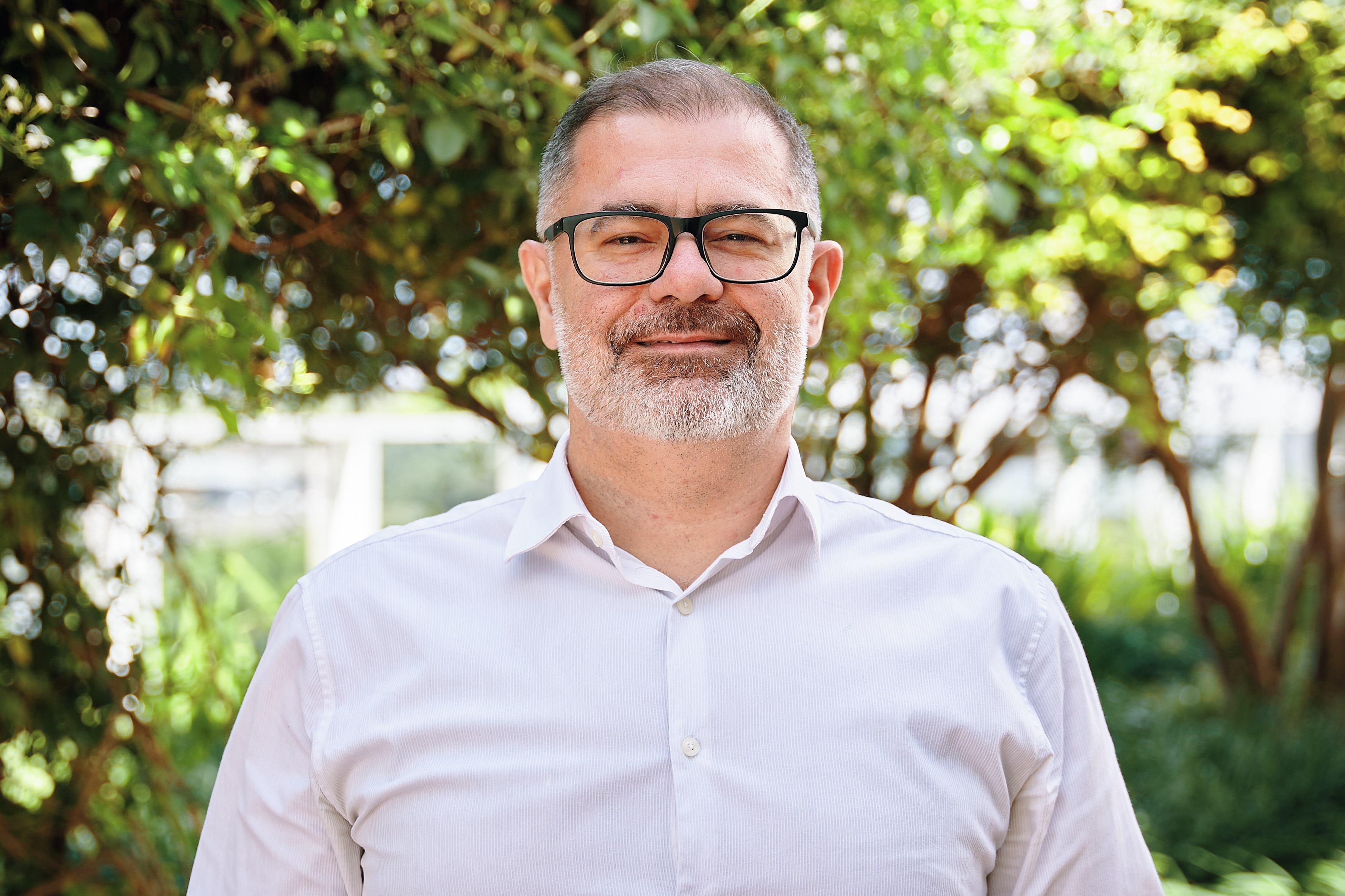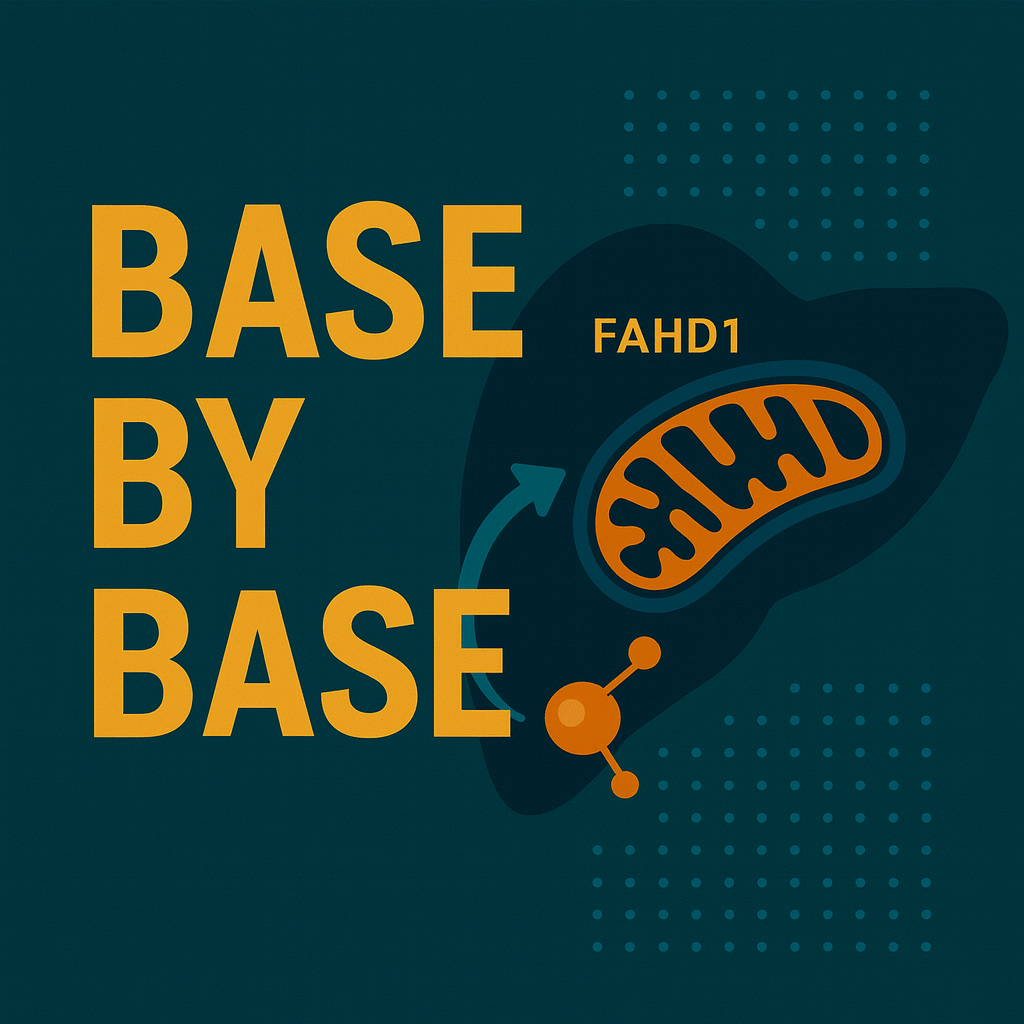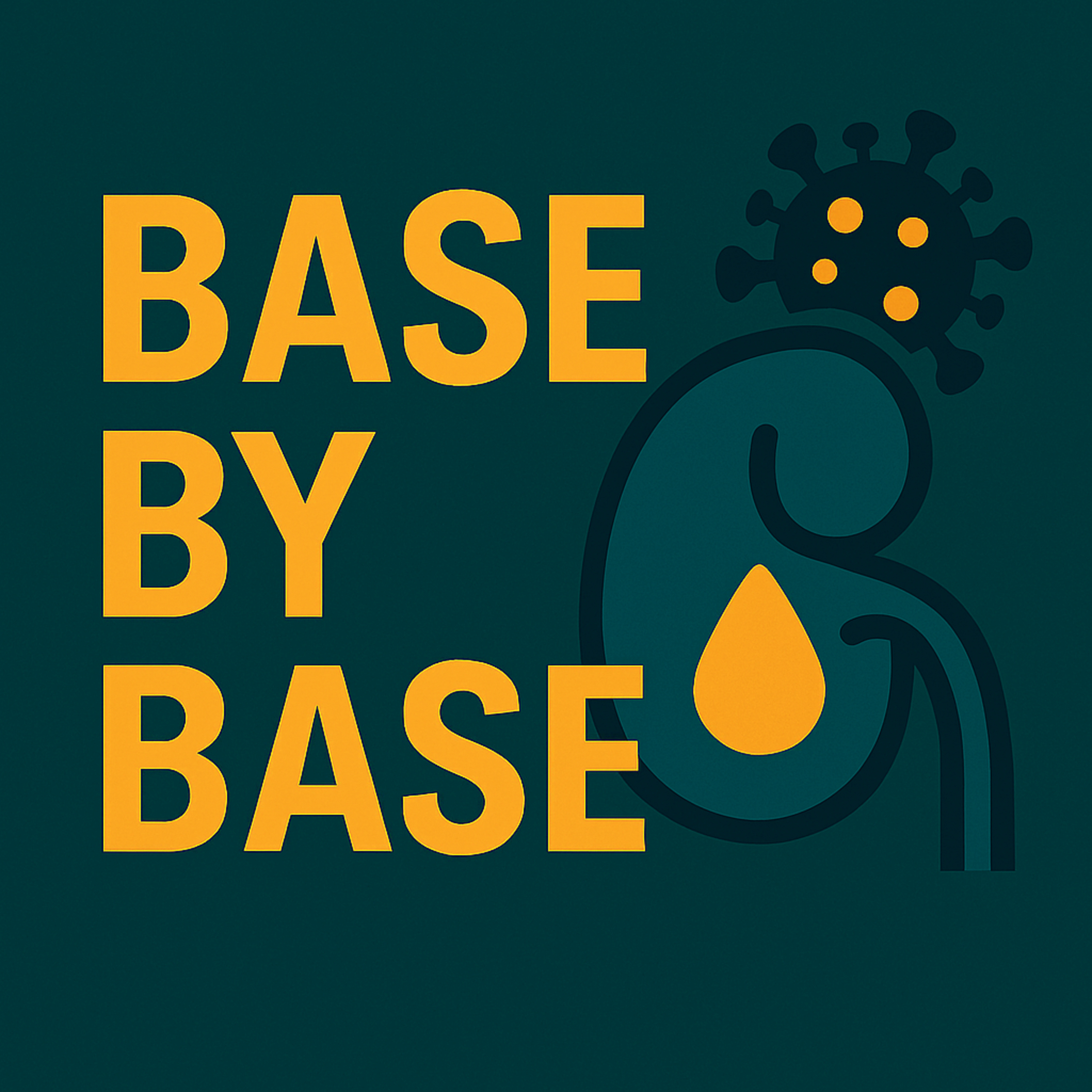Episode Transcript
[00:00:00] Speaker A: Foreign.
Welcome to Base by Base, the papercast that brings genomics to you wherever you are. What if the reason aggressive liver cancer resists our toughest treatments isn't just about its genetics?
What if it's actually about what fuel the tumor is choosing?
And maybe even where it's choosing to burn that fuel inside the tumor itself.
[00:00:33] Speaker B: Right. Because hepatocellular carcinoma, hcc, it's notoriously difficult to treat.
[00:00:38] Speaker A: Yeah, exactly. And we often blame the tumor microenvironment, the tme. Right. Saying it helps the cancer cells adapt and hide.
[00:00:46] Speaker B: Uh huh. We know cancer cells are metabolic shape shifters. They change how they make energy, but that's kind of general.
[00:00:52] Speaker A: It is. To really get a handle on the aggression, we need specifics, like who are the actual cells driving this metabolic shift? And crucially, where are they located within that complex tumor structure? Yeah.
[00:01:03] Speaker B: The spatial component is key.
[00:01:05] Speaker A: So today we're doing a deep dive into some fascinating work. It shows how just one specific mitochondrial enzyme, something you might even overlook, seems to act like a master conductor. It lets the most aggressive tumor cells fuel up, sure, but it also helps them, like actively build this shield, a shield against the immune system.
[00:01:23] Speaker B: It's a really elegant study linking metabolism directly to the immune environment.
[00:01:27] Speaker A: That's the core mission of the work we're unpacking today. The paper titled FAHD1 Mediated Pyruvate Metabolism in Hepatova Multi Omics and Causal Genetic Evidence, authored by Jinhuang Xiji Liang, Jimin sun and the team led by Hua Ping Chen, published recently in 2025.
[00:01:46] Speaker B: And this deep dive is definitely needed because. Well, this study is a fantastic example of spatial biology done. Right. They didn't just find a marker. They pulled together single cell data, spatial mapping, and some really rigorous genetic analysis.
[00:01:59] Speaker A: The causal inference part.
[00:02:00] Speaker B: Exactly. To pinpoint this metabolic linchpin for HCC aggression. So our goal today is to walk you through how they built that case and really explore how targeting this one enzyme might, you know, potentially change HCC therapy down the line.
[00:02:14] Speaker A: Before we jump into all the details, we really want to take a moment and celebrate the work of the team behind this. That's the key laboratory of Clin, Clinical Laboratory Medicine of Guangxi Department of Education, and the first Affiliated Hospital of Guangxi Medical University led by Hua Ping Chen. They've really pushed our understanding forward here.
[00:02:31] Speaker B: Absolutely. Great work. So maybe let's set the scene a bit, remind ourselves about the HCC challenge.
[00:02:36] Speaker A: Good idea.
[00:02:37] Speaker B: It's still a major cause of cancer deaths worldwide and a big Reason for that is treatment failure. The tumor just adapts, especially metabolically.
[00:02:46] Speaker A: Right. Metabolic reprogramming. We hear that term a lot. Often people think, okay, Warburg effect glycolysis, fast energy.
[00:02:53] Speaker B: Yeah, the classic view.
[00:02:54] Speaker A: But this work zooms right in on pyruvate metabolism. Why pyruvate? What makes it so central here?
[00:03:01] Speaker B: Well, pyruvate is kind of the gatekeeper, isn't it? It sits right at this crossroads between glycolysis, that fast sugar burning and the more efficient mitochondrial energy production, oxpos. But the key thing is pyruvate isn't just like waiting passively to be used. It seems to be an active driver of nasty tumor behaviors. Invasion. We've actually seen hints of this in other cancers like pyruvate carboxylase PC in breast cancer, that pushes a really invasive type.
[00:03:29] Speaker A: Ah, okay, so there's precedent.
[00:03:31] Speaker B: There is, but for hcc, the big questions were which enzyme is really pulling the strings for pyruvate here? And where in the tumor is this control happening? The spatial aspect was missing.
[00:03:43] Speaker A: Got it. So find the culprit and its location. That sounds like it needed some pretty advanced techniques. How did they actually get this high res, multi layered view? You mentioned three pillars.
[00:03:52] Speaker B: Yeah, exactly. Three main technical approaches working together. Pillar one was all about the who and the what. They used single cell RNA sequencing, SCRNA sec, lots of data public and their own. And they used several different computational methods, which is good for robustness to score pyruvate metabolism activity in every single cell type they found. That let them pinpoint exactly which cells were, you know, metabolically supercharged.
[00:04:16] Speaker A: Okay, so that identifies the hyperactive cells. Then pillar two gets us the where.
[00:04:20] Speaker B: Precisely. Once they knew who the players were, they brought in spatial transcriptomics, or st.
This is super cool technology. It basically maps gene activity onto a physical slice of the tissue.
[00:04:32] Speaker A: So you can see where the genes are firing.
[00:04:33] Speaker B: Exactly. They can literally see hot spots of high pyruvate activity and even trace how different tumor regions might be evolving. You see the geography of the metabolism, that's powerful.
[00:04:43] Speaker A: But finding hyperactive cells in certain sp.
But it's still correlation, right? Yeah. How did they nail down causality? That feels like the hardest part.
[00:04:50] Speaker B: It is. And that's where pillar three comes in. Summary Data based Mendelian randomization, or smr.
This is a. Well, a pretty sophisticated genetic statistics method. By integrating huge datasets, genetic variations in the liver, HCC risk data from large studies like Fingan, SMR lets you test for a causal link. Does changing the expression of gene X actually cause a change in HCC risk. It uses natural genetic variation like a randomized trial.
[00:05:18] Speaker A: Okay. Bypassing some of the usual bias issues you get with just observing things.
[00:05:22] Speaker B: Exactly. It gets you closer to cause and effect.
[00:05:25] Speaker A: And they mentioned a specific check within smr, something about a high peid value. Can you break that down? Why was that important for trusting the causal claim?
[00:05:34] Speaker B: Yeah, good point. The PID test is crucial. It's basically checking for confounding due to linkage disequilibrium. In simpler terms, sometimes two genes are located really close together on a chromosome, so they tend to be inherited together. So SMR might flag gene A as causal for the disease, but maybe it's actually gene B, which is just physically nearby and gets dragged along in the analysis. The Heidi test checks for this. A high P Heidi value, which they found gives you more confidence that the signal you're seeing for your target gene is real and not just because it's linked to some other causal gene nearby.
[00:06:09] Speaker A: Got it. So it strengthens the claim that the gene they identified is truly the independent driver. That's rigorous.
[00:06:15] Speaker B: It really is. It sets a high bar.
[00:06:17] Speaker A: Okay, so with this powerful toolkit, what was the first big finding? Who are these metabolically supercharged cells?
[00:06:23] Speaker B: Well, the CRNA SEC results pointed pretty clearly to the epithelial cells derived from the tumor itself. They just had way higher pyruvate metabolism scores than other cell types.
[00:06:34] Speaker A: Makes sense to cancer cells themselves.
[00:06:35] Speaker B: Right, but they drilled down further and identified this specific subset they called pyruvate hyperactive epith epithelial subpopulation, or PI HIEPI for short.
And these weren't just metabolically active. They showed really strong signs of increased stemness, like being more adaptable and able to seed new tumor growth. They had higher cytotrace scores, which measure that. And they were proliferating faster. More cells caught in the active phases of cell division.
[00:07:01] Speaker A: So basically, the engine of tumor growth and persistence.
[00:07:03] Speaker B: Pretty much. These look like the really aggressive clones.
[00:07:05] Speaker A: Okay, we found the aggressive population, the PI high EPI cells.
Now the million dollar question.
What's the molecular switch? What gene did the SMR analysis point to as the cause?
[00:07:18] Speaker B: This is where it gets really interesting. The SMR analysis, with that rigor we talked about, zeroed in on one gene, FAHD1. That's fumary lacetoacetate hydrolase domain containing one. And importantly, it was the only differentially expressed gene in that pyruvate pathway that showed a statistically significant causal link to HCC Susceptibility?
[00:07:39] Speaker A: The only one. Wow.
[00:07:40] Speaker B: The only one passing their strict criteria. And then they confirmed it functionally. They showed that epithelial cells positive for FEHD one really did proliferate faster, had more STEM like features, and crucially, higher pyruvate metabolism.
FHD1 looks like the key controller.
[00:07:58] Speaker A: Okay, hold on. FHD1? That. That doesn't ring the usual bells for cancer metabolism, like the Warburg effect enzymes. Yeah, isn't it usually involved in, like, amino acid breakdown or something? Tyrosine catabola.
[00:08:10] Speaker B: You're absolutely right. It's not one of the usual suspects, like, say, PDK or ldha. It's typically considered part of a more niche pathway.
[00:08:17] Speaker A: So why would this seemingly minor mitochondrial enzyme suddenly be the master regulator of aggression and liver cancer? That seems unexpected.
[00:08:26] Speaker B: It is unexpected, and that's the core insight here. FHD1's critical role isn't about just cranking out energy faster. It's more about metabolic control and stress survival.
[00:08:33] Speaker A: Control and survival.
[00:08:35] Speaker B: Okay, so Fahd1 works in the mitochondria. Its known job is to catalyze the decarboxylation of something called oxaloacetate, or oaa. OAA is a key molecule in the TCA cycle, the main mitochondrial energy engine.
[00:08:48] Speaker A: Right.
[00:08:48] Speaker B: By breaking down OAA, Fahd1 essentially acts like a brake, or maybe a pressure release valve on the TCA cycle.
[00:08:56] Speaker A: A break? Why would rapidly growing cancer cells want to break their main energy engineers?
[00:09:01] Speaker B: Ah, because when that engine runs too hot too fast, which happens during rapid proliferation, it generates a ton of reactive oxygen species, ros. These are damaging molecules. Too much ROS can actually kill the cancer cell.
[00:09:13] Speaker A: Oxidative stress.
[00:09:14] Speaker B: Exactly. So the thinking is, by efficiently getting rid of some OA, FEHD1 kind of throttles the TCA cycle just enough to keep ROS production under control. It prevents the mitochondria from basically burning themselves out.
[00:09:26] Speaker A: Wow.
Okay, so it lets the cell keep dividing quickly, but without suffering the toxic side effects of running its metabolism flat out. That's a clever survival strategy.
[00:09:35] Speaker B: It is, and it's a very different mechanism from just boosting glycolysis, like in the simple Warburg model. It's about managing mitochondrial stress that really reframes things.
[00:09:44] Speaker A: It's not just about speed, it's about sustainable speed and resilience. Now, let's connect this back to the where the spatial transcriptomics.
Where did they find these? Fahd 1 positive stress managing aggressive cells. Were they, like, at the invasion front?
[00:10:00] Speaker B: You might think so, but no. The ST data showed a really clear pattern metabolic zonation.
The highest pyruvate scores driven by these FAHD1 cells were predominantly concentrated right in the tumor cores.
[00:10:14] Speaker A: In the core, not the edges.
[00:10:16] Speaker B: Not primarily on the invasive edge. No. More like they were bunkered down in the central regions like the command center inside a fortress, managing operations from within.
[00:10:24] Speaker A: O. Interesting. And were they just sitting there managing their own metabolism, or were they talking to their neighbors building that fortress?
[00:10:30] Speaker B: They were definitely talking. This is where the niche remodeling comes in. The spatial analysis uncovered really strong evidence of communication between these FHD1 plus epithelial cells and another key cell type, cancer associated fibroblasts, or cfs.
[00:10:44] Speaker A: Ah, the CFS often accomplices in cancer.
[00:10:47] Speaker B: Major accomplices.
And the specific communication link they found involved the HP ITGB2 ligand receptor PA.
The FAHD1plus cells seem to use this pathway to interact directly with the cfs.
[00:11:01] Speaker A: And what does that interaction do to the neighborhood?
[00:11:04] Speaker B: It seems to actively reshape the local environment.
This interaction fosters a niche that's drenched in two really potent signaling molecules. Transforming growth factor and vascular endothelial growth factor.
[00:11:17] Speaker A: Okay, TGF beta and vegf. Those are big red flags for immune suppression.
[00:11:22] Speaker B: Huge red flags. So the implication is that this little mitochondrial enzyme, FAHD1, isn't just controlling the cell's internal state. It's orchestrating the construction of an immunosuppressive barrier around the tumor core.
[00:11:33] Speaker A: How does that work? How do TGF beta and VEGF build that shield?
[00:11:37] Speaker B: Well, TGF beta is notorious for directly suppressing antitumor immune cells, especially T cells. It basically tells them to calm down or even exhaust them.
Vegf, on the other hand, messes with the tumor blood vessels, making them chaotic and leaky.
This actually prevents immune cells like T cells from physically getting into the tumor core effectively. It's like building walls and drugging the guards.
[00:12:00] Speaker A: So, FAHD1 activity, HP, ITGB2 communication, BAC, CFS activate TGF beta and VEGF release immune cells blocked and suppressed.
[00:12:10] Speaker B: Wow. That seems to be the chain of events suggested by the data. It directly links Fahd1's metabolic role to creating an immune hostile environment, which obviously helps the tumor resist cells therapies, especially immunotherapies.
[00:12:22] Speaker A: That connection is incredibly powerful. Okay, so this sounds like it should have real clinical implications. How did the researchers translate this knowledge into something potentially useful for doctors and patients?
[00:12:32] Speaker B: They moved fast on that. They developed a prognostic tool, an FAHD1 derived risk score, which they called FRS. They built it using the expression levels of eight genes that correlated strongly with FAHD1 activity.
[00:12:44] Speaker A: An eight gene signature.
[00:12:45] Speaker B: Yep.
And when they tested this FRS in patient cohorts, it worked remarkably well. Patients who had a high FRS score had significantly worse overall survival compared to those with a low score. It looks like a pretty robust way to stratify patients based on this FAHG1 driven biology.
[00:13:03] Speaker A: Okay, predicting prognosis is valuable, but what really jumped out at me was the connection they found to immunotherapy response. That seemed almost paradoxical.
[00:13:12] Speaker B: It did seem a bit counterintuitive at first glance. Yeah, you'd think, okay, high FRS means high FHD1, lots of TGF beta and VEGF, strong immune suppression. So surely those patients would respond poorly to immunotherapy, right?
[00:13:25] Speaker A: That would be the logical assumption, but.
[00:13:27] Speaker B: They found the opposite. The FRS predicted that these high risk patients, the ones with high FRS scores, actually showed a better response specifically to anti PD1 therapy, including drugs like mevolumab, compared to other treatments like sorafenib or tace.
[00:13:40] Speaker A: Better response despite the immunosuppression. How does that work?
[00:13:43] Speaker B: The interpretation is quite nuanced. It suggests that while the tumor core is highly immunosuppressive, in these high FRS patients, the immune cells that do manage to get in or near that environment, the T cells are likely getting absolutely hammered by signals like PD L1, which PD1 inhibitors target, and TGF beta. They're present, but they're profoundly exhausted.
[00:14:04] Speaker A: Ah, I see. So the high risk environment creates a strong need for T cell exhaustion.
[00:14:09] Speaker B: Exactly. It creates a situation where T cell exhaustion is a dominant feature. And that's Precisely what Anti PD1 therapies are designed to overcome. They take the brakes off those exhausted T cells. So, paradoxically, the very factors making the tumor aggressive and immunosuppressive also make it particularly vulnerable to having that specific break released by checkpoint inhibitors.
[00:14:30] Speaker A: That makes the FRS score potentially very powerful for selecting patients who would benefit most from anti PD1 drugs.
[00:14:36] Speaker B: Potentially, yes. It could be a really useful biomarker for tailoring immunotherapy strategies.
[00:14:40] Speaker A: Okay, prediction is one thing. Did they go further and look for ways to actually target this FAHD1 pathway directly, find a drug?
[00:14:48] Speaker B: They did. They used computational drug prediction methods, basically screening databases of existing drugs to see which ones might counteract the gene signature associated with high frs. And one drug popped up as the top candidate. Tevazanib.
[00:15:02] Speaker A: Tevozanib. I know that name. Isn't that already an approved drug?
A VEGFR inhibitor?
[00:15:07] Speaker B: It is. It's approved for Renal cell carcinoma, I believe. It's known primarily as a selective inhibitor of vascular endothelial growth factor receptors. So hitting the VEGF part of the niche remodeling we talked about.
[00:15:19] Speaker A: Okay, so it might work by blocking the VEGF signaling that FEHD1 indirectly promotes.
[00:15:25] Speaker B: That's one possibility. But they went a step further with computational modeling. Molecular docking. They simulated how Tivazinib might find physically interact with the FAHD1 protein itself. And the simulation predicted a surprisingly strong binding affinity, a favorable binding energy. Minus 7.7 kilometolkalamol. Which suggests tivozenib might actually bind directly to FEHD1 and inhibit its enzymatic activity.
[00:15:48] Speaker A: Wait, really? So Chivozinib might be a dual inhibitor, hitting VEGF receptors and directly blocking the FAHD1 enzyme that helps build the immunosuppressive niche in the first place?
[00:15:58] Speaker B: That's the tantalizing possibility raised by the computational work. If true, that would be incredibly potent, hitting both the internal metabolic stress management and the external immune shield construction with one drug.
[00:16:10] Speaker A: But docking is still a computer simulation, right? It's not proof.
[00:16:13] Speaker B: Absolutely not proof. And the paper is very clear about this being a limitation and a crucial next step. They state explicitly that you need direct biochemical validation. Yeah, meaning actual lab experiments. You need cellular assays and enzymatic assays to show that Tibozonib physically binds to the FAHD1 protein and stops it from working.
Stops it from breaking down oaa.
[00:16:34] Speaker A: Okay, and what about confirming the whole metabolic mechanism? The OAA breakdown, the ROS control?
[00:16:40] Speaker B: That also needs direct validation, ideally using something like isotopic flux analysis. That's where you feed cells labeled molecules and actually trace where the atoms go through the metabolic pathways in real time.
That would confirm exactly how FAHD1 is tweaking the PCA cycle and affecting ROS.
[00:16:59] Speaker A: Got it. And the communication with the CFS, the HPITGB2 link, same story.
[00:17:04] Speaker B: The computational work points strongly to that interaction, but it needs functional testing. You'd want to use, say, 3D CO culture systems, where you grow the FAHD1 tumor cells together with the CFS and see if blocking ITGB2 actually prevents the release of TGF beta and VEGF, and maybe even allows immune cells to function better in that mix.
[00:17:24] Speaker A: So lots of exciting next steps to confirm these mechanisms in the lab.
[00:17:27] Speaker B: Definitely. But the current study provides a really compelling multiomics roadmap.
[00:17:32] Speaker A: So, boiling it all down, what's the main take home message here?
[00:17:34] Speaker B: I think the big takeaway is how this study repositions pyruvate metabolism and specifically this one enzyme, FAHD1. It's not just about fuel. It's acting as a spatial organizer for how HCC evolves. It connects the intrinsic traits of the most aggressive cells, their stemness, their ability to survive metabolic stress directly to the way they actively build an immunosuppressive neighborhood.
[00:17:58] Speaker A: Around themselves, linking the inside to the outside.
[00:18:00] Speaker B: Exactly. And that Insight suggests targeting Fahd1 could be a really smart, maybe dual pronged strategy. You might cripple the tumor's internal survival mechanisms and dismantle its external immune shield simultaneously.
[00:18:13] Speaker A: Which leads to a provocative yeah, what.
[00:18:16] Speaker B: Does this really mean for how we design treatments, especially for those high risk HCC patients identified by the FRS score? How should we think about combining immunotherapy like anti PD1, perhaps with a drug like Tevazanib? If it really does inhibit Fahd1, could that be a synergistic combination?
[00:18:32] Speaker A: Okay, that's quite the comprehensive metabolic and spatial map we've navigated today. We've gone from observing single cells all the way to a potential new clinical strategy.
[00:18:41] Speaker B: It really does shift how you might think about metabolic targets in cancer, doesn't it? It's clearly not just about stopping the energy supply, it's about disrupting this intricate network of stress management and communication that allows the tumor to thrive and defend itself.
[00:18:56] Speaker A: This episode was based on an Open Access article under the CC BY 4.0 license. You can find a direct link to the paper and the license in our episode. Description if you enjoyed this, follow or subscribe in your podcast app and leave a comment. 5 star rating if you'd like to support our work, use the donation link in the description. Thanks for listening and join us next time as we explore more science base by base.




